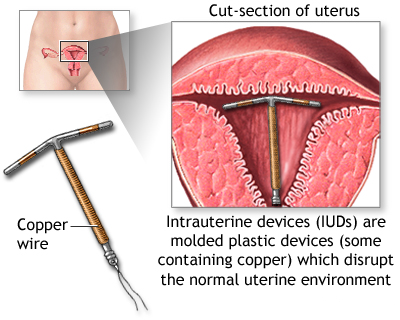Intrauterine devices (IUD)
Contents
Why the Procedure is Performed
An intrauterine device (IUD) is a small plastic T-shaped device used for birth control. It is inserted into the uterus where it stays to prevent pregnancy.
Description
An IUD is usually inserted by your health care provider during your monthly period. Either type can be inserted quickly and easily in the provider's office or clinic.
- The provider slides a plastic tube containing the IUD through the vagina and into the uterus.
- Using a plunger in the tube, the provider pushes the IUD into the uterus.
- The provider removes the tube, leaving two small strings that dangle outside the cervix within the vagina.
The strings have two purposes:
- They let the provider or woman check that the IUD stays properly in position.
- They are used to pull the IUD out of the uterus when it is time to remove it. This should only be done by a health care provider.
This procedure can cause discomfort and pain, but not all women have the same side effects. During insertion, you may feel:
- Little pain and some discomfort
- Cramping and pain
- Dizzy or light-headed
Some women have cramps and backaches for 1 to 2 days after insertion. Other may have cramps and backaches for weeks or months. Over-the-counter pain relievers can ease the discomfort.
Why the Procedure is Performed
IUDs are an excellent choice if you want:
- A long-term and effective birth control method
- To avoid risks and side effects of contraceptive hormones
But you should learn more about IUDs when deciding if you want to get an IUD.
An IUD can prevent pregnancy for 3 to 10 years. Exactly how long the IUD will prevent pregnancy depends on the type of IUD you are using.
IUDs can also be used as an emergency contraception. It must be inserted within 5 days of having unprotected sex.
Risks
While uncommon, IUDs carry some risks:
- There is a small chance of getting pregnant while using an IUD. If you do get pregnant, your provider can remove the IUD to lower the risk of miscarriage or other problems.
- A higher risk of an ectopic pregnancy, but only if you do get pregnant while using an IUD. An ectopic pregnancy is one that occurs outside the womb. It can be serious, even life-threatening.
- A rare chance the IUD may make a hole in the uterine wall when it is inserted.
Before the Procedure
Talk with your provider about whether an IUD is a good choice for you.
Also ask your provider:
- What you can expect during the procedure
- What your risks might be
- What you should watch for after the procedure
For the most part, an IUD can be inserted at any time:
- Right after giving birth
- After an elective or spontaneous miscarriage
If you have an infection, you should NOT have an IUD inserted.
Your provider may advise you to take an over-the-counter painkiller before getting the IUD inserted. If you are sensitive to pain in your vagina or cervix, ask for a local anesthetic to be applied before the procedure starts.
After the Procedure
You may want to have someone drive you home after the procedure. Some women have mild cramping, low backache, and spotting for a couple of days.
If you have a progestin-releasing IUD, it takes about 7 days for it to start to work. You do not need to wait to have sex. But you should use a backup form of birth control, such as a condom, for the first week.
Your provider will want to see you 4 to 6 weeks after the procedure to be sure the IUD is still in place. Ask your provider to show you how to check that the IUD is still in place, and how often you should check it.
An IUD can slip partly or all of the way out of your uterus. If this happens, contact your health care provider right away. Do NOT try to remove an IUD that has come part of the way out or has slipped out of place.
Call your health care provider right away if you have:
- Flu-like symptoms
- Fever
- Chills
- Cramps
- Pain, bleeding, or fluid leaking from your vagina


